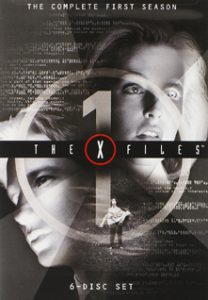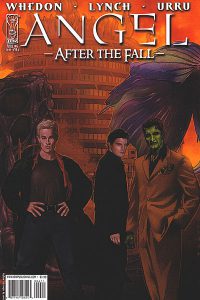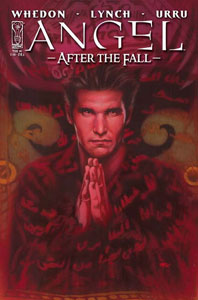Seeing the success of “Buffy” Season 8 and learning that Brian Lynch’s pitch for an “Angel” “Season 6” lined up closely with his plans before the TV show was canceled, Joss Whedon launched “Angel: After the Fall” in 2007. Although it makes some of IDW’s previous work hard to fit into the continuity, it goes without saying that it’s great to get Whedon’s canonical story of what happens to Angel and company after the cliffhanger of “Not Fade Away” (5.22).
The start of “After the Fall” (Issues 1-5, November 2007-March 2008)
We don’t start directly at the cliffhanger, though. Using a tactic that’s popular in comics and would later be used a lot on TV, Whedon and Lynch jump ahead in the narrative. This approach can sometimes be gimmicky (making us wait for backstories on “Walking Dead”) and sometimes beautiful (“This Is Us” is a master of non-sequential storytelling).
The technique mostly works in the first five issues of the 17-issue “After the Fall,” where Los Angeles has been sent to Hell by Wolfram & Hart, a way of punishing Angel for taking them on – although W&H does not have much sway in this chaotic dimension. We get great final-panel surprises like “Gunn’s a vampire!” and “Angel’s human!” Also, Wesley is a ghost who can’t get out of his W&H contract; Spike is a lord overseeing an army of women warriors; Connor, Gwen and Nina are helping humans get to a safe house; and Lorne, also a lord, has carved out a magically protected paradise in Silver Lake.
This information flows nicely into the narrative, as Angel – continuing from his late-Season 5 attitude — ticks off a demon lord and sets up a deal: If Angel defeats all the L.A. crime lords (or their chosen champions) in battle, the lords will cede control to him. Most of the revelations are new to Angel, too, so a reader feels tied to him. We’re even ahead of him on some things. Angel had lost track of Gunn in the early moments after the TV cliffhanger and doesn’t know his fate.
Franco Urru’s pages are busy and dark when you flip through them, yet vibrant and energetic when you soak them in. Coming off a couple “Spike” romps scripted by Lynch, Urru is the ideal artist to portray L.A. going to Hell. This place of ruins, fires and monsters seems awful, but I love visiting it from a safe remove, absorbing the details and all the best supporting characters who were on the TV series too little.
These five issues aren’t as heavy on fights and plot logistics as I remembered; there’s good character stuff in here, and on a re-read, it’s a feature – not a bug – that the arcs are spread out over 17 issues. The fact that the sun and full moon are out simultaneously in Hell causes Nina to be more wolf than human, even though she looks human. Vampire Gunn believes he can be good without a soul, but that premise is immediately on shaky ground as we see him torture fan-favorite (and Joss-favorite) floating telepathic fish Betta George (from the “Spike” comics).

In the latest cliffhanger – to be picked up in Issue 9 – Illyria is in wild-card mode: What will this powerful Old One do next in the battle? Whose side is she on? The end of Amy Acker’s performance as Illyria is the biggest blow from “Angel’s” TV cancellation, but it’s wonderful to see Whedon’s plans for the character carried out in comics, at least. Illyria is the hardest character to pin down in these early issues, but still one I am intrigued by.
4 stars

“First Night” interlude (Issues 6-8, April-June 2008)
Lynch (working from Whedon’s plotting, and assisted by a variety of artists who step in for Urru) finally answers the question of what happens right after “Not Fade Away” – sort of. Angel, Spike, Illyria and Gunn fight monsters for a bit, but very soon they are warped into different parts of L.A.-as-Hell, where they must get their bearings. The writers set aside Angel and Illyria, although we get hints that Angel tames the dragon rather than killing it, and Illyria is more psychologically unstable than ever.
Still, there’s great – and essential – stuff here, split into short tales. In the best story, W&H tries to tempt Wesley with the promise of an eternity of pleasure with Fred, but he correctly surmises “You’re not her.” Still, like Holland Manners in Season 2, Wesley is contractually bound to W&H, even after death. It’s a bleak situation, but it’s neat that Wesley is nobler than ever in the afterlife.
The Gunn yarn is second-best. Gravely injured, he’s turned by a group of vampires that wants him on their side (for as yet unknown reasons). He quickly kills his sire and we can see he’s poised to take over this gang.
The Connor-and-Kate two-parter is fun, because they are both talking about a man who has influenced them, with neither realizing they are talking about the same man: Angel. It explains why Connor knows his true past (it comes back to him in a flash when L.A. goes to Hell), but it leaves us wondering why Kate wasn’t in Issues 1-5.
The Spike tale is short and exactly what we’d expect: He had told himself he was done being a champion, but he sees two damsels in need, saves them from a monster, and soon has a whole gaggle of citizens following him. Lorne’s is also straightforward, but it’s presented as a poem: Depressed from having to kill Lindsey in “Not Fade Away,” he stumbles through town and ends up lord of the magically protected Silver Lake, with a new lease on life.
The Gwen story is essential to her character: As with Connor’s memories, her electric powers return with L.A.’s transformation.
And there you have it. We’re caught up except for the big mystery of Illyria and the small question of Kate, and we’re missing the story of how Angel tames and allies with the dragon. Leaving us hanging on those points is a slight cheat, but I admit it works. Bring on the rest of “After the Fall” …
4 stars
Click here for an index of all of John’s “Buffy” and “Angel” reviews.

